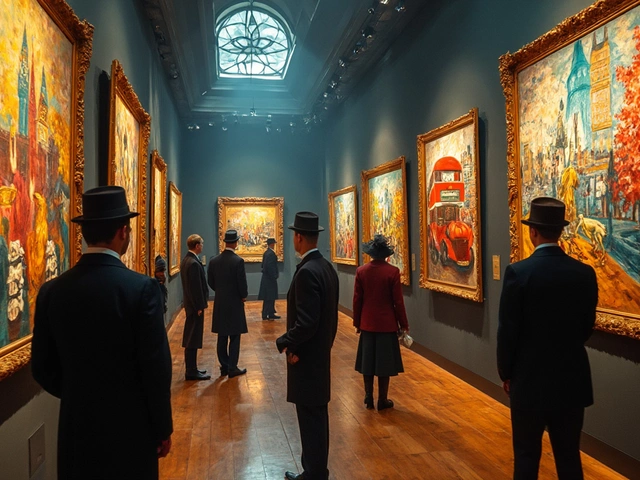Discovering Fluxus: A Motley Crew of Artists
I can't help but recall the first time I stumbled across the Fluxus movement. Isla, my better half, had filled our house with a smorgasbord of peculiar art pieces and musical compositions, all stemming from this eccentric vibe that Fluxus introduced. To put it simply, Fluxus was, or still is, an avalanche of experimental multi-media, pushing the boundaries of what we perceive as art.
Expressing the heartbeat of the 1960s, Fluxus artists emerged as a motley crew, composed of not just artists, but also composers, designers, and architects. Yet, all of them challenged the traditional concept of art, breaking it down, atom by atom, and knitting it back together into a new understanding. The monolithic fortress of 'high art' trembled under their unconventional exploits, making Fluxus an instrumental movement in shifting the perception of art.
Fluxus: The Collaboration of Multiple Art Forms
Fluxus was more than just art. It was a melting pot of visual art, music, and literature, combined to create a genre-defying art form. Where traditional art forms were separate and distinct, Fluxus saw the opportunity to blend, blur and sometimes obliterate these boundaries. Paintings could sing, sculptures could tell a story, and music could paint a picture. Even the name Fluxus, Latin for 'flow', reflects this fluidity and the transformation of static art forms into dynamic, living entities.
The brilliance of this interdisciplinary approach was that it pulled audiences into the heart of the work, making them an integral part of the entire artistic process. Fluxus pieces are not just items to be observed or sounds to be heard – they are experiences. This kinesthetic involvement marked a radical transformation in the spectator's role in art, reconfiguring the traditional relationship between the artwork, the artist, and the audience.
The Fluxus Manifesto: Art for Everyone
The guiding force behind the movement was George Maciunas, who penned the Fluxus manifesto in 1963 with the audacious proclamation of wanting to 'promote a revolutionary flood and tide in art.' He envisioned an art world free from the notion of art as a privilege of the elite, instead promoting it as something everyone could partake in and appreciate.
In his audacious manifesto, Maciunas advocated for simplicity over complexity, inclusivity over elitism, and humor over seriousness, summarizing what would become the pillars of Fluxus. This art movement was nothing short of a creative democracy, aimed to make art a regular part of everyday lives, in our discussions, our homes, and our cities, instead of being enclosed within the intimidating walls of museums.
The Notable Artists and their Works
Unleashing a pool of diverse talents, Fluxus saw a range of avant-garde artists such as Yoko Ono, Joseph Beuys, and Nam June Paik, each with their unique contribution. Yoko Ono’s 'Cut Piece,' where she sat motionless on a stage and invited the audience to cut a piece from her clothing, is a stark example of Fluxus art. Furthermore, the iconic 'Electronic Superhighway' by Nam June Paik reflects the blend of video art and electronically manipulated images that Fluxus enthusiastically endorsed.
The element of surprise, unpredictability, and rawness was central to their work. Each piece was a curious amalgamation of sights, sounds, and experiences, a medley that transcended the boundaries of traditional forms of expression, artfully treading on the border of chaos and harmony.
Fluxus: The Legacy Continues
Fluxus today might seem less radical than it did during its heyday, largely credited to its success in challenging the status quo that has since broadened the definition of art. However, its effects pervade the contemporary art world. Whether in the form of performance art at local festivals or street musicians using unconventional instruments, the spirit of Fluxus lives on.
To some, Fluxus might seem like a tumultuous cacophony, a random collection of images, sounds, and emotions. But to others, like Isla, and myself, it is a celebration, a radical symphony fusing multiple art forms, invoking a shared humanity so profound that it transcends the labels of class, tradition, and convention. This transformative capability makes Fluxus an art movement that truly transcends boundaries.
Experience Fluxus: Where to Start?
If you're as intrigued by Fluxus as I was when I first discovered it, you might be wondering where to start. Dive into the works of the aforementioned artists. Every gallery, every piece, and every performance is a different journey into the world of Fluxus. And don’t forget to explore this movement in your local art scene – who knows, you might just be the next Fluxus genius, waiting to transform the world in your unique way.
As you dive into Fluxus, remember, it's not just about understanding or decoding every piece. It's about letting the pulsating energy wash over you, allowing the art to envelop you in its exuberance. Fluxus is a wild ride on the roller coaster of the senses, a dance across the canvas of your understanding. So sit back, buckle up, and enjoy the experience – and above all, let the artwork speak to you.




